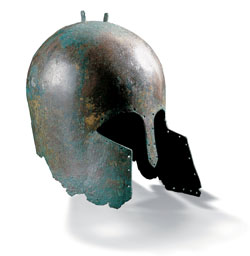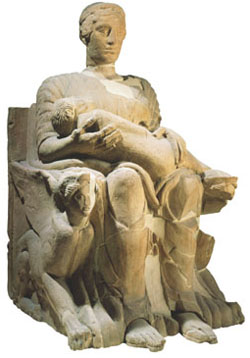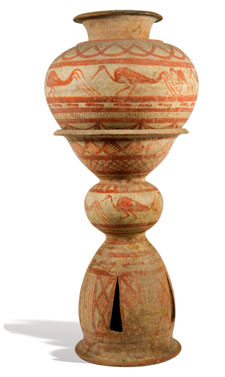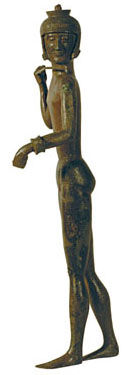Meadows Museum presents Etruscan art exhibit
The Meadows Museum launches the most comprehensive exhibition of Etruscan art ever undertaken in the U.S.

DALLAS (SMU) – The Meadows Museum at Southern Methodist University will present From the Temple and the Tomb: Etruscan Treasures from Tuscany, the most comprehensive exhibition of Etruscan art ever undertaken in the U.S., from January 25 to May 17, 2009.
 Click to view slide show of exhibit items. |
More than 400 objects spanning the 9th through 2nd centuries B.C.E. will be featured, drawn primarily from the renowned Florence Archaeological Museum, as well as from several smaller Italian museums and private collections. Many of the objects have never before traveled to the U.S.
In addition, a complementary exhibition in the downstairs galleries, New Light on the Etruscans: Fifteen Years of Excavation at Poggio Colla, presents for the first time in North America the fascinating findings from an interdisciplinary archaeological research project, the SMU-led excavations at the Etruscan site of Poggio Colla, near Florence, Italy. Nearly 100 objects from the site will be displayed, along with new scientific evidence relating to Etruscan daily life and religious rituals.
The Meadows Museum is the exclusive venue for both exhibits.
Many view Tuscany as the cradle of the western artistic tradition. Well before Rome became a world power, when in fact Rome was only a small farming village on the banks of the Tiber River, central Italy was ruled by the Etruscans. Along with the Phoenicians and the Greeks, they were one of the three great powers of the ancient Mediterranean. Their formidable maritime skills, wide-reaching trade and rich mineral resources made them fabulously wealthy. They were outstanding metalworkers, engineers and city planners whose art and architecture profoundly affected the Romans. Considered the most religious of ancient peoples, they were ruled by a theocratic elite that controlled every aspect of Etruscan life; priest/magistrates were believed to be skilled at interpreting the will of the gods. At the same time, Etruscan society gave unusual freedom and power to women (which scandalized the Greeks and Romans.)

The Florence Archaeological Museum holds one of the finest collections of Etruscan art in the world, and some of the choicest objects from its collection will be shown at the Meadows, illustrating every aspect of Etruscan life and afterlife over almost a thousand years. The quality of Etruscan craftsmanship and range of artistic techniques is represented with examples of stone carving, elaborate polychrome terracotta sarcophaguses and funerary urns, sophisticated bronzes, and delicate gold and silver jewelry.
The Etruscans were master metal workers; their skill at creating decorative objects in bronze was much admired by the Greeks, and adapted by the Romans. The exhibition will include ritual objects, such as votive bronzes offered to the gods in sanctuaries, as well as outstanding bronze vases, cooking and serving utensils, perfume flasks, a variety of implements such as strigils (used to wipe off oil or water after bathing), bronze lamp stands and candelabra, and bronze furniture. Of particular note is a group of four exceptional human figures, about 14 inches tall and dating to around 550 B.C.E., which are making their first appearance in the U.S. They were found in a votive deposit not far from the modern town of Arezzo. The remains of attachments can be seen on the tops of their heads, indicating they were originally supports of an impressive object, perhaps a throne. One of the figures brandishes a spear, while another wears a long belted dress and necklace.
Also featured for the first time in the U.S. will be an entire, 29-foot-long temple pediment from the 2nd century B.C.E. – the terracotta decoration for the front of an Etruscan temple – showing that the Etruscans were masters at working terracotta as well as bronze. The pediment depicts the legend of the Seven Against Thebes, the story of the fatal power struggle of Oedipus’s twin sons after their father stepped down as king of Thebes.

In later years, Etruscan tombs include stone sarcophaguses with elaborate decorations and figural elements. One example includes a reclining figure on its lid, with a round stomach and a finger ring – the stereotypical obesus etruscus often parodied in Roman literature and theater. From the Roman point of view, this figure represents the wealthy, easy-living aristocrat, decadent descendant of a once-proud military culture, and the reason the Etruscans allowed themselves to be conquered in the fourth century B.C.E.
Another monumental stone sculpture found in a chamber tomb is the "Mater Matuta," in which a female figure is depicted sitting upon a throne with a child in her lap. The work has not been shown in the U.S. before.
Other artifacts from tombs, including ash urns, guardian animals and demons, and splendid silver, ivory and ceramic objects, will also be featured.
"Etruscan art reveals an incredible variety of styles, ranging from naturalistic depictions of humans and animals that foreshadow later Roman portraits to abstracted figures that look so remarkably un-classical they might have been done in the 20th century A.D.E. rather than the 6th century B.C.E.," said Dr. Mark A. Roglán, director of the Meadows Museum. "We are very pleased to be partnering with the Florence Archaeological Museum to introduce visitors to the liveliness and vigor of Etruscan art, bringing to life a vibrant but lost culture at the heart of the Mediterranean tradition."

About the Meadows Museum
The Meadows Museum, a division of SMU’s Meadows School of the Arts, houses one of the largest and most comprehensive collections of Spanish art outside of Spain, with works dating from the 10th to the 21st century. It includes masterpieces by some of the world’s greatest painters: El Greco, Velázquez, Ribera, Murillo, Goya, Miró and Picasso.
The museum is located at 5900 Bishop Blvd. on the campus of SMU, three blocks west of the DART light rail Mockingbird Station.
Hours are 10 a.m. to 5 p.m. Tuesday, Wednesday, Friday and Saturday; 10 a.m. to 8 p.m. Thursday; and 12-5 p.m. Sunday. Admission is $8 per person, free on Thursday evenings after 5 p.m., and free for children under 12, museum members, and SMU faculty, staff and students. Ample free parking is available in the museum garage.
For information, call 214.768.2516 or visit the museum’s web site at www.meadowsmuseumdallas.org.
# # #